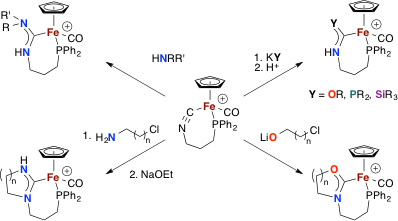
“Phosphine-Tethered Carbene Ligands: Template Synthesis and Reactivity of Cyclic and Acyclic Functionalized Carbenes”
Reaction of the phosphine-tethered isocyanide iron(II) complex 1, [CpFe(CO)(PCN)]I, with primary and secondary amines forms the corresponding acyclic (diamino)carbene complexes [CpFe(CO)(PCXNH)]I; X = n-butylamine (4), 4-methylaniline (5), dihexylamine (6). Five- and six-membered cyclic (diamino)carbene complexes [CpFe(CO)(PCNHN-nCy)]I (n = 5 (9), 6 (10)) are generated in two steps from the reaction of 1 with 2-chloroethyl and 3-chloropropylamine, first forming acyclic diaminocarbene complexes [CpFe(CO)(PCNXNH)]I (X = chloroethyl (7), chloropropyl (8)), respectively, followed by deprotonation and intramolecular cyclization. This methodology is not effective for alcohols; however, acyclic (oxy)(amino)carbene complexes are produced in two steps by the reaction of 1 with potassium methoxide, ethoxide, and isopropoxide to form the corresponding ylidene complexes CpFe(CO)(PCO(X)N) (X = Me (11), Et (12), i-Pr (13)), which, in the second step, can be protonated with an equimolar amount of HBF4 to form acyclic (oxy)(amino)carbene complexes [CpFe(CO)(PCO(X)NH)]BF4 (X = Me (14), Et (15), i-Pr (16)). Five and six-membered cyclic (oxy)(amino)carbene complexes [CpFe(CO)(PCNO-nCy)]Cl (n = 5 (17), 6 (18)) are formed by the concerted reaction of 1 with 2-chloroethoxide and 3-chloropropoxide followed by intramolecular cyclization. The reversible conversion of acyclic (silyl)(amino)carbene complex [CpFe(CO)(PPhCSi(Ph)3NH)]BF4 (20) to its ylidene precursor CpFe(CO)(PPhCSi(Ph)3N) (19) via slow deprotonation with an equivalent of NaHB(OAc)3 is demonstrated, and the structure of 20 is reported. All complexes were characterized by IR and NMR spectroscopy and, where possible, by single-crystal X-ray diffraction. DFT calculations were used to support the electronic structure of complexes deduced from structural and spectroscopic data.